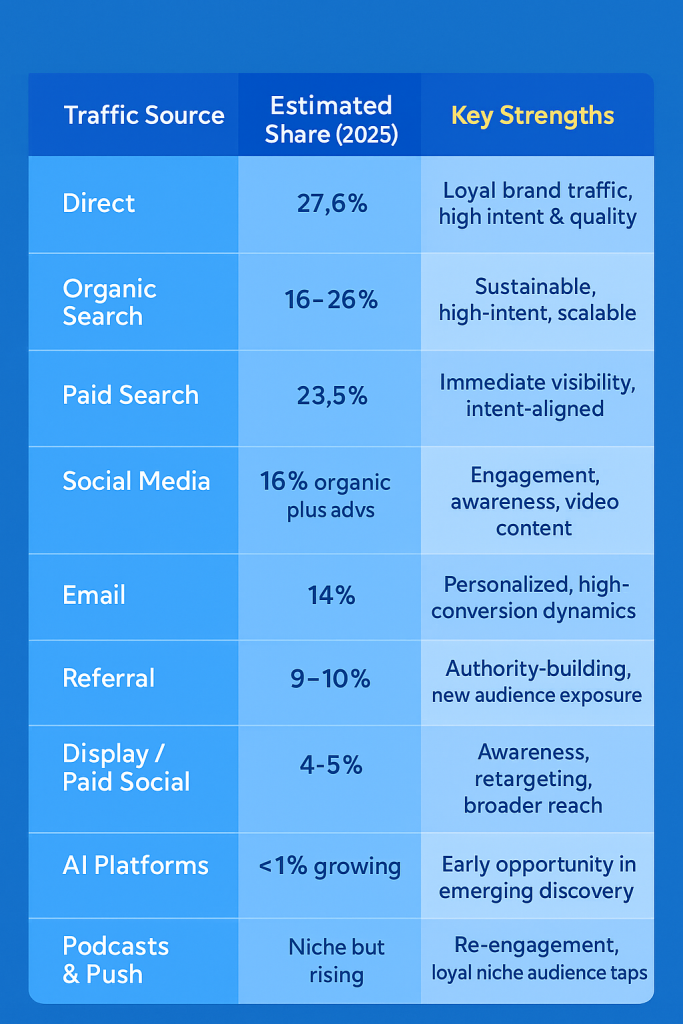
Top Traffic Sources for RSOC in 2025: What’s Working Now
In 2025, the landscape of digital traffic sources continues to evolve rapidly. From organic search to AI-powered platforms, understanding where your audience comes from and how they’re accessing your content is more critical than ever. Here’s a comprehensive breakdown of what’s working for RSOC, based on real data and trends.
1. Direct Traffic: The Power of Brand Recall
Direct traffic remains the single largest driver of site visits in 2025. Across multiple studies, it consistently represents a dominant share, ranging from 27–28% of overall web traffic.
Why it works:
- Reflects brand awareness and loyalty, users typing your URL or clicking bookmarks.
- Indicates trust, often translating into higher engagement and conversion rates.
- Benefits from offline branding, repeat visitors, and memorable content.
Actionable tips:
A tip for maintaining relevance is to build brand presence via PR, events, physical collateral, and word-of-mouth. Maintain a clean, memorable domain name and encourage bookmarks and embed clear site references in email signatures, newsletters, and videos.

2. Organic Search: Still a Foundational Channel
Despite the rise of AI, organic search remains crucial, accounting for 16–26% of traffic.
What’s new in 2025:
- AI overlays and featured snippets require content designed for voice, context, and readability.
- Google defends that click volume is “relatively stable,” though certain audiences (e.g., forums, reviews).
- Other search engines like Bing and Yahoo still provide valuable niche traffic, especially when enhanced with AI integrations.
In order to keep organic searches is to target long-tail and intent-driven keywords crafted for AI-driven search. Structure content for featured snippets, AI overviews, and voice search. And finally, focus on evergreen, informative content with strong on-page and technical SEO.
3. Paid Search: Immediate Visibility
Paid search remains a powerful traffic engine. Some data shows it accounts for approximately 23.5% of visits.
Why it’s still effective:
- Offers instant visibility on competitive keywords.
- ROI improves with sophisticated targeting and optimization.
- Complements organic and direct traffic, enabling multi-touch conversion journeys.
Actionable tips are referred to as running well-targeted PPC campaigns, as well as optimizing ad copy, landing pages, and continually A/B testing creative. It is important to monitor cost-per-acquisition and align spend with conversion goals.
4. Social Media: Engagement Is King
Social media continues to be vital, driving 16% of web traffic.
2025 trends:
- Short-form video dominates (TikTok, Reels, Shorts)—platforms that generate >2× engagement of longer content and influence buying decisions for 57–73% of users.
- Platforms like TikTok are growing fast in retail influence, while Facebook and Instagram see slight declines.
Investing in short-form videos with strong CTAs will drive blog or landing page visits. Using hashtags, trends, and platform analytics for reach and targeting will drive more social media traffic. Combine organic engagement with influencer collaborations to amplify reach.
5. Email Marketing: The Personalized Channel
Email remains one of the most reliable “owned” channels, responsible for around 14% of traffic.

Why it’s valuable:
- High engagement from users who’ve opted in.
- Personalization and segmentation drive visits and conversions.
- Great for keeping repeat audiences engaged with newsletters, updates, and promotions.
Build your list consistently with lead magnets (e.g., guides, exclusive content).
- Segment by interest, behavior, or lifecycle stage.
- Optimize subject lines, send times, and include clear CTAs with trackable UTM links.
6. Referral Traffic and Guest Blogging
Referral traffic (via backlinks, guest posts, and mentions) still matters, with around a 9–10% share.
Why does it perform well? It is because it tends to come from trusted, relevant sites, builds authority and helps improve SEO, and offers exposure to new audiences.
Actionable tips:
- Contribute quality guest posts to authoritative sites.
- Get mentioned in industry articles, podcasts, and roundups.
- Foster relationships with niche bloggers and media for link opportunities.
7. Emerging & Alternative Channels
Several newer avenues are gaining traction:
A. AI-Driven Platforms
Traffic via AI (e.g., ChatGPT, Perplexity) is emerging, it is just about 0.17%, but is expected to grow.
Google’s AI Overviews can improve CTR when optimized for context-rich answers.
How to tap in? Create authoritative, well-structured content that AI systems can reference and use Q&A formats, definitions, and concise explanations.

B. Push Notifications & Podcasts
- Push notifications help re-engage users quickly.
- Podcasts can drive niche fans via show notes and verbal CTAs.
Tips to drive this type of traffic: Set up opt-in push tools (e.g., OneSignal) with timely alerts; appear on niche podcasts or sponsor episodes with website links in show notes.
8. Paid Social and Display Ads
While not top conversion drivers, these types of traffic sources still play a strategic role. Display ads contribute around 4.3% of traffic, and social ads can be effective when paired with targeting. Paid social and display ads are useful for remarketing and broad awareness.
Tips for growing: use display for retargeting interested users and align creatives with your brand voice and landing pages.
9. Measuring What Matters
Having awareness of sources is one thing, understanding quality is another. Use GA4, Search Console, and engagement tools to assess:
- Traffic share by source.
- Conversion metrics (e.g., form submissions, purchases).
- Engagement quality: session duration, bounce rate, pages per session
- Real business metrics like revenue and acquisition cost, rather than just pageviews.

Final Thoughts
In 2025, the most successful RSOC strategies don’t rely on one channel; they harness diverse channels:
- Core foundations: Direct, organic, and paid search.
- Engagement drivers: Email, social (especially short-form videos).
- Authority builders: Referrals, guest content.
- Emerging frontiers: AI-driven discovery, push notifications, podcasts.
Above all, focus on quality over quantity. Traffic sources that sticks, explores, converts, and comes back is far more valuable than raw volume.
So, tailor your content, optimize across platforms, monitor, and adapt because in 2025, digital traffic is full of opportunity.
